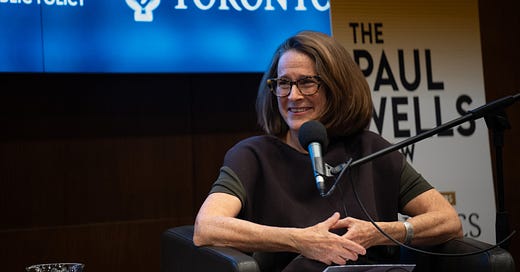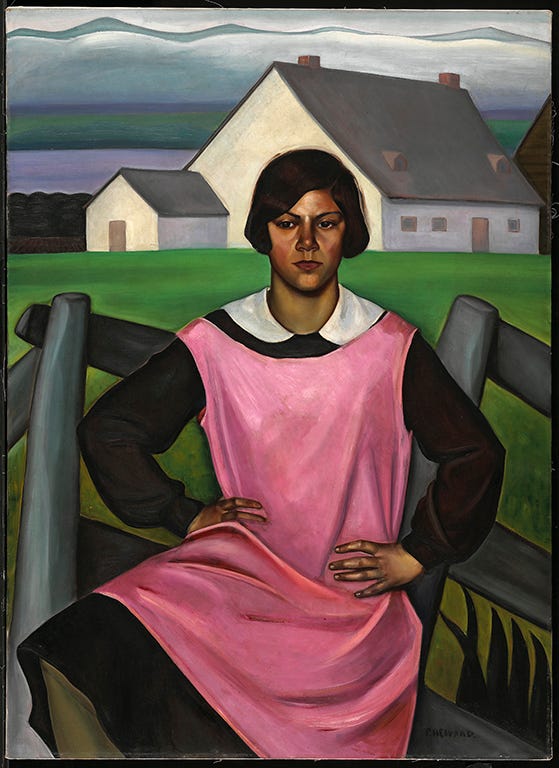A canvas as big as the country
On the podcast, the chief curator of a very Canadian art museum
Here’s some audio of Sarah Milroy walking me through a gravesite.
It’s a little huddle of marker stones on the grounds outside the McMichael Canadian Art Collection, an art museum in Kleinburg, a short drive north of Toronto. Buried under the stones are most of the Group of Seven, some with spouses. Robert and Signe McMichael, who founded the museum, are down there too, somewhere, next to the painters they loved. The spot marks an area where several of the Group of Seven used to spend lazy summer afternoons under the trees, in their twilight years. It’s all gorgeous and weird and sweet and creepy. The music critic Greil Marcus once wrote a book called The Old Weird America. This is the old weird Canada, if you want some.
It’s also further and further from what the McMichael Gallery is up to these days. Or rather, if the early-20th-century landscape-painting sausage factory remains at the centre of McMichael’s mission, its radius is expanding at lightning speed.
I’ve been talking to Sarah Milroy, who’s the McMichael’s senior curator, for several months about what’s going on in her shop. She’s such an engaging advocate for art that I put her on the list for my January week of public interviews at the University of Toronto’s Munk School. The other guests were former finance minister Bill Morneau and the great historian Margaret MacMillan, whom you’ve already heard; and Toronto International Film Festival CEO Cameron Bailey, who’ll be the subject of a future episode, just ahead of the Oscars. I know as well as anyone that Sarah Milroy is less of a household name than the others. I also trust my judgment. She’s a great talker, and what she and her colleagues are doing at McMichael is a story I’m happy to share.
There probably isn’t a school bus in Toronto that hasn’t dropped a few loads of schoolkids off at the McMichael, where for decades a narrow definition of Canadian art was brilliantly represented. Robert McMichael had a deal with the Ontario government — almost a contract, which he took to be binding, limiting who could be shown at his grand cabin-like museum. The Group of Seven were on the list, of course, and Emily Carr, and Norval Morisseau, and not many others.
In the 1990s a new generation of curators started expanding the list, not without some spirited opposition from McMichael. He actually sued. He actually won. The government of the day appealed. He died. Everyone is tremendously grateful for his wonderful bequest, and now the definition of Canadian art at the medium’s flagship gallery is: art that was made in Canada.
The exhibition that best encapsulates that bigger idea is Uninvited: Canadian Women Artists in the Modern Moment, a blockbuster show that Milroy curated to mark the Group of Seven’s centenary in 2020. Uninvited is on tour as the National Gallery of Canada’s major summer exhibition in Ottawa, starting this weekend. Alert readers will recall some of my recent coverage of goings-on at the NGC, and I continue to keep an eye on the place, but I cannot recommend Uninvited more highly.
Its premise is simple: Who wasn’t featured at the G7’s first show in Toronto in 1920? One obvious answer is “Women,” and Uninvited is an opulent showcase of art produced by women painters, sculptors, beadworkers, weavers and photographers, non-Indigenous and Indigenous, nearly 200 works in all. Artists like Paraskeva Clark and Pegi Nicol MacLeod, Elizabeth Katt Petrant and Anne Savage and Prudence Heward….
… In other words, artists who even now aren’t household names. But who perhaps should be. Can be. Because the artists in Uninvited used different techniques than the Group of Seven and very often chose different subjects (these paintings sometimes have people in them!), the exhibition comes off as an expansive alternate history of Canadian art. It tells a bigger story than the one we thought we knew.
The McMichael is in the bigger-story business these days. When I visited the gallery in January, Milroy showed me wooden masks carved with formidable skill by Dempsey Bob, a Northwest Coast woodcarver. Paintings and sculptures by Rajni Perera that combine imagery from her birthplace in Sri Lanka with ideas of a dystopian future. Paintings by William Kurelek, a devout Roman Catholic, depicting Jewish life in the Prairies that mark the biggest single acquisition in the Gallery’s history. And a mural by Anishnaabe/Ojibwe artist Bonnie Divine that launches an intensive examination by the McMichael of the deeper history of the grounds on which it was built. Turns out this land was a crossroads a few centuries before Robert McMichael got there.
Here’s my feature interview with Sarah Milroy about all that’s new, or newly valued, in Canadian art. On Apple Podcasts:
And here’s how to find it on other podcast platforms.
The Founding Sponsor of The Paul Wells Show is Telus. Our Title Sponsor is Compass Rose. I’m grateful for the support they all provide. In Toronto, I’m the inaugural Journalist Fellow-in-Residence at the University of Toronto’s Munk School of Global Affairs and Public Policy, where this interview with Sarah Milroy took place. Our Ottawa partner is the National Arts Centre. Antica Productions handles production for the podcast. The Toronto Star and iPolitics distribute and promote The Paul Wells Show.
Thanks for listening, subscribing, telling your friends and spreading the word.







I will definitely make sure I get to see this show at the McMichael. It sounds like a fantastic opportunity to see some rarer and under appreciated work. I'm relatively new to Toronto and this appears to be a great introduction to some local history. This curator however is extremely off putting. She's terribly glib and her snide little bon mots about what she seems to be clearly fighting against are unwelcome. To my ear she has contempt for the ideas that the McMichael fought to enshrine and perhaps even for the G7 themselves. Just let the phrase "Mighty Whitey" in reference to the founder sink in for a while. There is substantive mission creep setting in here and it motivates me to go see the place before ideologues like this wreak further havoc.
I will be among the least of Paul's fans on his art-museum coverage, I'm not much for it.
BUT - "Uninvited" was at the Vancouver Museum last summer, and we caught it with some Spanish/French relatives who live minutes from the Prado, have been to the Louvre more than they could count - and *they* were impressed, much less myself. There are indeed a lot of people not famous, who deserve to be.